brake light Lexus IS250 2011 Using The Hands-Free Phone System (For Mobile Phones) / LEXUS 2011 IS250/IS350 OWNERS MANUAL (OM53839U)
[x] Cancel search | Manufacturer: LEXUS, Model Year: 2011, Model line: IS250, Model: Lexus IS250 2011Pages: 576, PDF Size: 7.16 MB
Page 3 of 576

1
2
3
4
5
6
7
3
2-1. Driving proceduresDriving the vehicle ........................ 124
Engine (ignition) switch .............. 134
Automatic transmission.............. 139
Manual transmission .................... 145
Turn signal lever ............................ 147
Parking brake ................................. 148
Horn.................................................... 150
2-2. Instrument cluster Gauges and meters ....................... 151
Indicators and warning lights................................................. 157
Multi-information display........... 160
2-3. Operating the lights and windshield wipers
Headlight switch ............................ 165
Fog light switch .............................. 168
Windshield wipers and washer............................................. 169
Headlight cleaner switch ........... 174 2-4. Using other driving systems
Cruise control ................................ 175
Intuitive parking assist ................. 179
Driving assist systems.................. 185
2-5. Driving information Cargo and luggage ........................ 191
Vehicle load limits ......................... 194
Winter driving tips ........................ 195
Trailer towing .................................. 199
Dinghy towing (vehicles with an automatic
transmission) .............................. 200
Dinghy towing (vehicles with a manual
transmission) ................................ 201
2When driving
Page 13 of 576
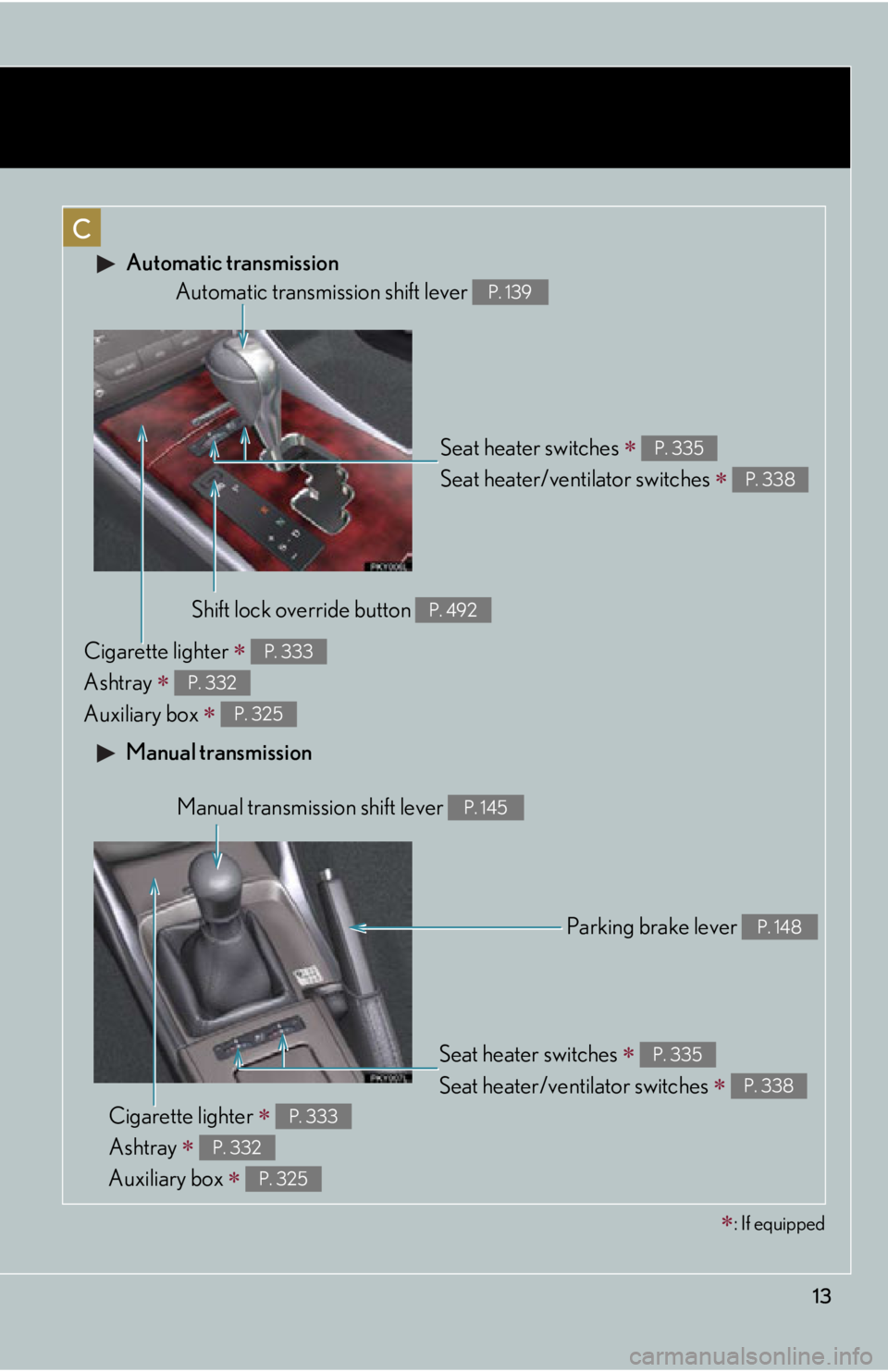
13
C
Automatic transmission
Manual transmission
Seat heater switches
Seat heater/ventilator switches
P. 335
P. 338
Automatic transmi ssion shift lever P. 139
Shift lock override button P. 492
Cigarette lighter
Ashtray
Auxiliary box
P. 333
P. 332
P. 325
Manual transmission shift lever P. 145
Parking brake lever P. 148
Cigarette lighter
Ashtray
Auxiliary box
P. 333
P. 332
P. 325
Seat heater switches
Seat heater/ventilator switches
P. 335
P. 338
: If equipped
Page 14 of 576
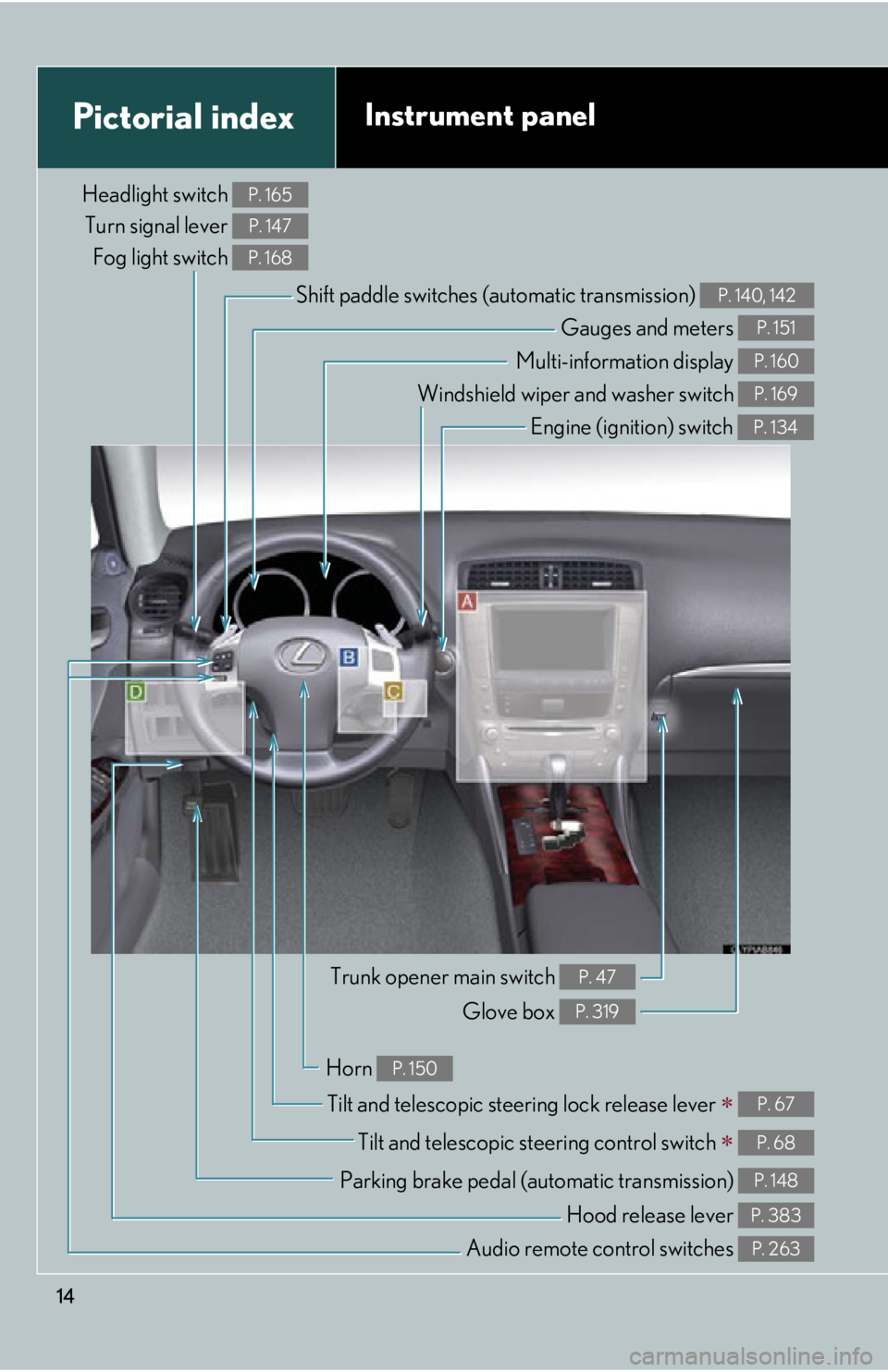
14
Pictorial indexInstrument panel
Headlight switch Turn signal lever Fog light switch P. 165
P. 147
P. 168
Shift paddle switches (a utomatic transmission) P. 140, 142
Gauges and meters P. 151
Multi-information display P. 160
Windshield wiper and washer switch P. 169
Engine (ignition) switch P. 134
Trunk opener main switch P. 47
Glove box P. 319
Tilt and telescopic steering lock release lever P. 67
Tilt and telescopic steering control switch P. 68
Parking brake pedal (automatic transmission) P. 148
Audio remote control switches P. 263
Horn P. 150
Hood release lever P. 383
Page 123 of 576

When driving2
123
2-1. Driving proceduresDriving the vehicle.................. 124
Engine (ignition) switch ......... 134
Automatic transmission ........ 139
Manual transmission .............. 145
Turn signal lever ....................... 147
Parking brake ........................... 148
Horn ............................................ 150
2-2. Instrument cluster Gauges and meters ................. 151
Indicators and warning lights ......................................... 157
Multi-information display ..... 160
2-3. Operating the lights and windshield wipers
Headlight switch...................... 165
Fog light switch ........................ 168
Windshield wipers and washer ..................................... 169
Headlight cleaner switch....... 174 2-4. Using other driving
systems
Cruise control........................... 175
Intuitive parking assist ............ 179
Driving assist systems ............ 185
2-5. Driving information Cargo and luggage ................. 191
Vehicle load limits ................... 194
Winter driving tips .................. 195
Trailer towing ........................... 199
Dinghy towing (vehicles with an
automatic transmission).... 200
Dinghy towing (vehicles with a
manual transmission) .......... 201
Page 125 of 576
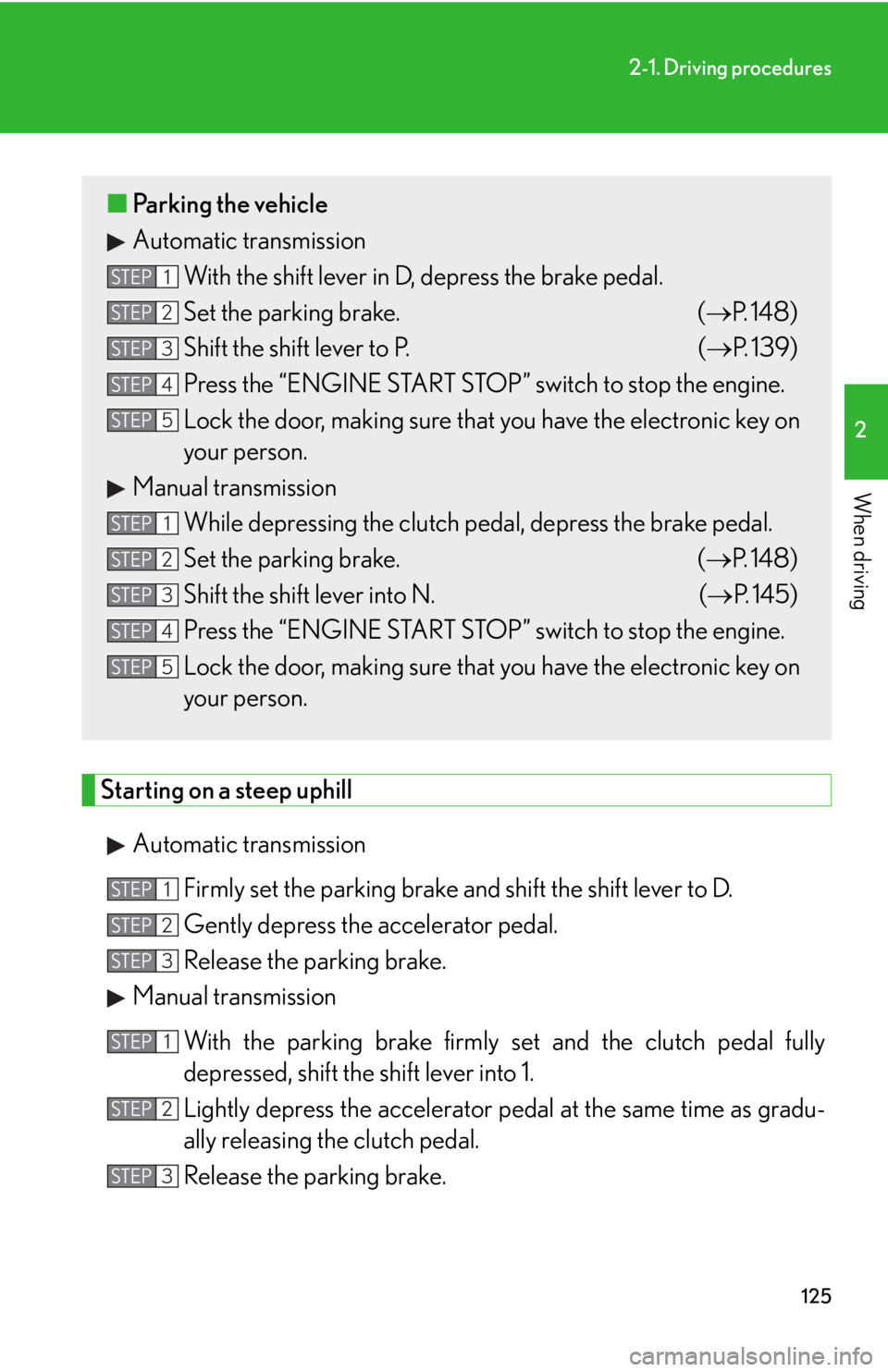
125
2-1. Driving procedures
2
When driving
Starting on a steep uphillAutomatic transmission Firmly set the parking brake and shift the shift lever to D.
Gently depress the accelerator pedal.
Release the parking brake.
Manual transmission
With the parking brake firmly set and the clutch pedal fully
depressed, shift the shift lever into 1.
Lightly depress the accelerator pedal at the same time as gradu-
ally releasing the clutch pedal.
Release the parking brake.
■ Parking the vehicle
Automatic transmission
With the shift lever in D, depress the brake pedal.
Set the parking brake. ( P. 1 4 8 )
Shift the shift lever to P. ( P. 1 3 9 )
Press the “ENGINE START STOP” switch to stop the engine.
Lock the door, making sure that you have the electronic key on
your person.
Manual transmission While depressing the clutch pedal, depress the brake pedal.
Set the parking brake. ( P. 1 4 8 )
Shift the shift lever into N. ( P. 145)
Press the “ENGINE START STOP” switch to stop the engine.
Lock the door, making sure that you have the electronic key on
your person.
STEP1
STEP2
STEP3
STEP4
STEP5
STEP1
STEP2
STEP3
STEP4
STEP5
STEP1
STEP2
STEP3
STEP1
STEP2
STEP3
Page 127 of 576

127
2-1. Driving procedures
2
When driving
CAUTION
■When starting the vehicle
With automatic transmission vehicles, always keep your foot on the brake pedal
while stopped with the engine running. This prevents the vehicle from creeping.
■When driving the vehicle
●Do not drive if you are unfamiliar with the location of the brake and accelerator
pedals to avoid depressing the wrong pedal.
• Accidentally depressing the accelerator pedal instead of the brake pedal will
result in sudden acceleration that may le ad to an accident that could result in
death or serious injury.
• When backing up, you may twist your bo dy around, leading to a difficulty in
operating the pedals. Make sure to operate the pedals properly.
• Make sure to keep a correct driving posture even when moving the vehicle only slightly, allowing you to depress the brake and accelerator pedals prop-
erly.
• Depress the brake pedal using your right foot. Depressing the brake pedal using your left foot may delay response in an emergency, resulting in an acci-
dent.
●Do not drive the vehicle over or stop the vehicle near flammable materials.
●With automatic transmission vehicles, do not let the vehicle roll backwards while
the shift lever is in a driving position, or roll forward while the shift lever is in R.
Doing so may cause the engine to stall or lead to poor brake and steering perfor-
mance, resulting in an accident or damage to the vehicle.
●If the smell of exhaust is noticed inside the vehicle, open the windows and check
that the trunk is closed. Large amounts of exhaust in the vehicle can cause driver
drowsiness and an accident, resulting in death or a serious health hazard. Have
the vehicle inspected by your Lexus dealer immediately.
●Do not under any circumstance s shift the shift lever to P, R or N (vehicles with an
automatic transmission) or R (vehicles with a manual transmission) while the vehi-
cle is moving.
Doing so can cause significant damage to the transmission system and may result
in a loss of vehicle control.
●Do not shift the shift lever to N while the vehicle is moving.
Doing so may cause the engine brake to not operate properly and lead to an
accident.
Page 129 of 576

129
2-1. Driving procedures
2
When driving
CAUTION
■When driving on slippery road surfaces
●Sudden braking, acceleration and steering may cause tire slippage and reduce
your ability to control the vehicle, resulting in an accident.
●Sudden changes in engine speed, such as engine braking caused by up-shifting
or down-shifting, may cause the vehicl e to skid, resulting in an accident.
●After driving through a puddle, lightly depress the brake pedal to make sure that
the brakes are functioning properly. Wet brake pads may prevent the brakes from
functioning properly. If the brakes on on ly one side are wet and not functioning
properly, steering control may be af fected, resulting in an accident.
■When shifting the shift lever
With automatic transmission vehicles, be ca reful not to shift the shift lever with the
accelerator pedal depressed.
This may lead to unexpected rapid acceleration of the vehicle that may cause an
accident and result in death or serious injury.
■When the vehicle is stopped
●Do not race the engine.
If the vehicle is in any gear other than P (vehicles with an automatic transmission
only) or N the vehicle may accelerate suddenly and unexpectedly, and may cause
an accident.
●Do not leave the vehicle with the engine running for a long time.
If such a situation cannot be avoided, park the vehicle in an open space and
check that exhaust fumes do no t enter the vehicle interior.
●With automatic transmission vehicles, in order to prevent accidents due to the
vehicle rolling away, always keep depressing the brake pedal while the engine is
running, and apply the parking brake as necessary.
●If the vehicle is stopped on an incline, in order to prevent accidents caused by the
vehicle rolling forward or backward, always depress the brake pedal and securely
apply the parking brake as needed.
●Avoid revving or racing the engine.
Running the engine at high speed whil e the vehicle is stopped may cause the
exhaust system to overheat, which could result in a fire if combustible material is
nearby.
Page 130 of 576

130
2-1. Driving procedures
CAUTION
■When the vehicle is parked
●Do not leave glasses, cigarette lighters, spray cans, or soft drink cans in the vehi-
cle when it is in the sun.
Doing so may result in the following.
• Gas may leak from a cigarette lighter or spray can, and may lead to a fire.
• The temperature inside the vehicle may cause the plastic lenses and plastic
material of eye glasses to deform or crack.
• Soft drink cans may fracture, causing the contents to spray over the interior of the vehicle, and may also cause a short circuit in the vehicle's electrical com-
ponents.
●Always apply the parking brake, shift the shift lever to P (vehicles with an auto-
matic transmission only), stop the engine and lock the vehicle.
Do not leave the vehicle unattend ed while the engine is running.
●Do not touch the exhaust pipe while the engine is running or immediately after
turning the engine off.
Doing so may cause burns.
●Do not leave the engine running in an area with snow build-up, or where it is
snowing. If snowbanks build up around the vehicle while the engine is running,
exhaust gases may collect and enter the vehi cle. This may lead to death or a seri-
ous health hazard.
■Exhaust gases
Exhaust gases include harmfu l carbon monoxide (CO) that is colorless and odor-
less. Inhaling exhaust gases may lead to death or a serious health hazard.
●If the vehicle is in a poorly ventilated ar ea, stop the engine. In a closed area, such
as a garage, exhaust gases may collect and enter the vehicle. This may lead to
death or a serious health hazard.
●The exhaust should be checked occasionally. If there is a hole or crack caused by
corrosion, damage to a joint or abnormal exhaust noise, be sure to have the vehi-
cle inspected and repaired by your Lexus dealer. Failure to do so may allow
exhaust gases to enter the vehicle, result ing in death or a serious health hazard.
Page 148 of 576
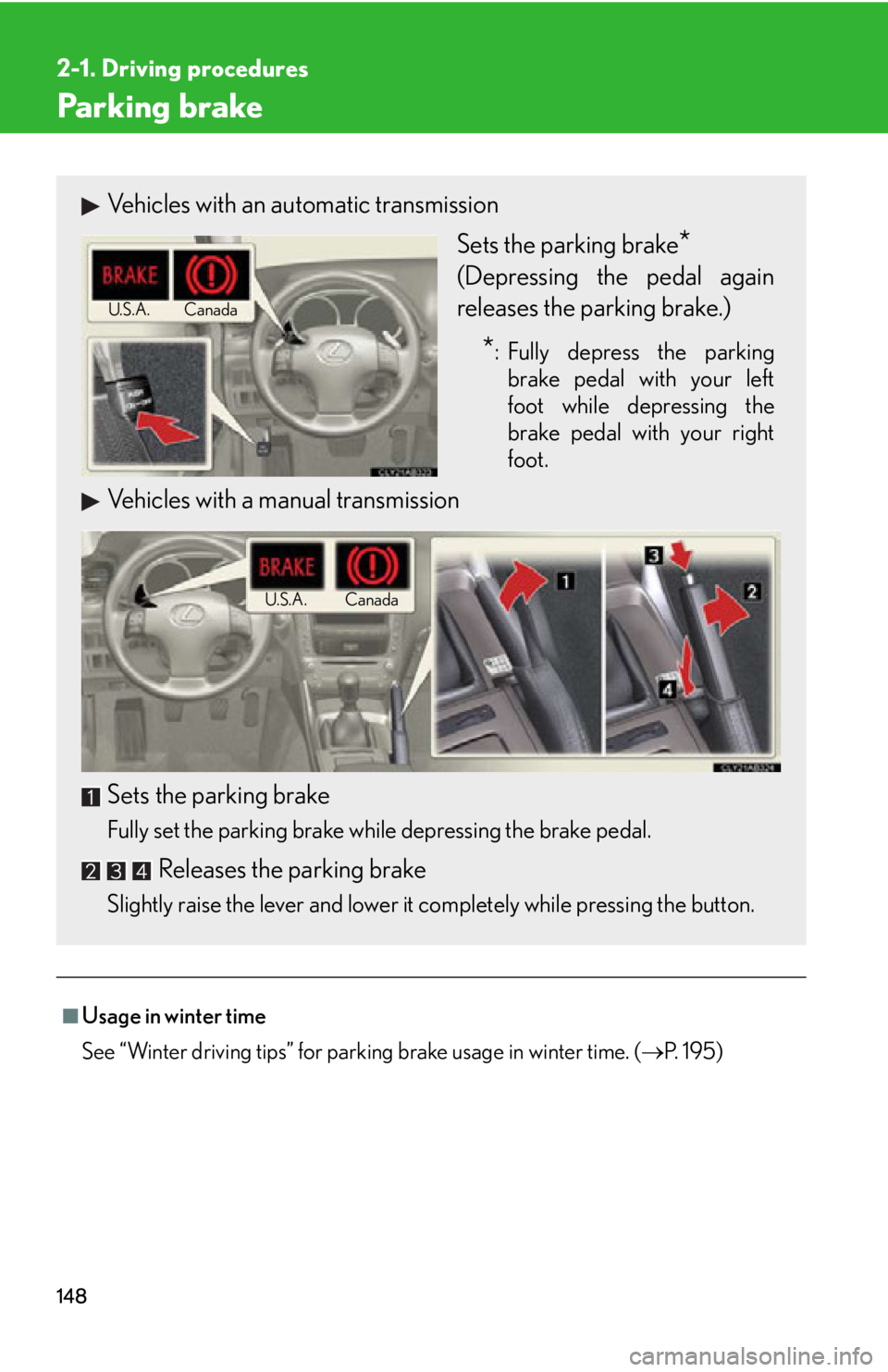
148
2-1. Driving procedures
Parking brake
■Usage in winter time
See “Winter driving tips” for parking brake usage in winter time. (P. 195)
Vehicles with an automatic transmission
Sets the parking brake
*
(Depressing the pedal again
releases the parking brake.)
*: Fully depress the parkingbrake pedal with your left
foot while depressing the
brake pedal with your right
foot.
Vehicles with a manual transmission
Sets
the parking brake
Fully set the parking brake while depressing the brake pedal.
Releases the parking brake
Slightly raise the lever and lower it completely while pressing the button.
Canada
U.S.A.
Canada
U.S.A.
Page 166 of 576
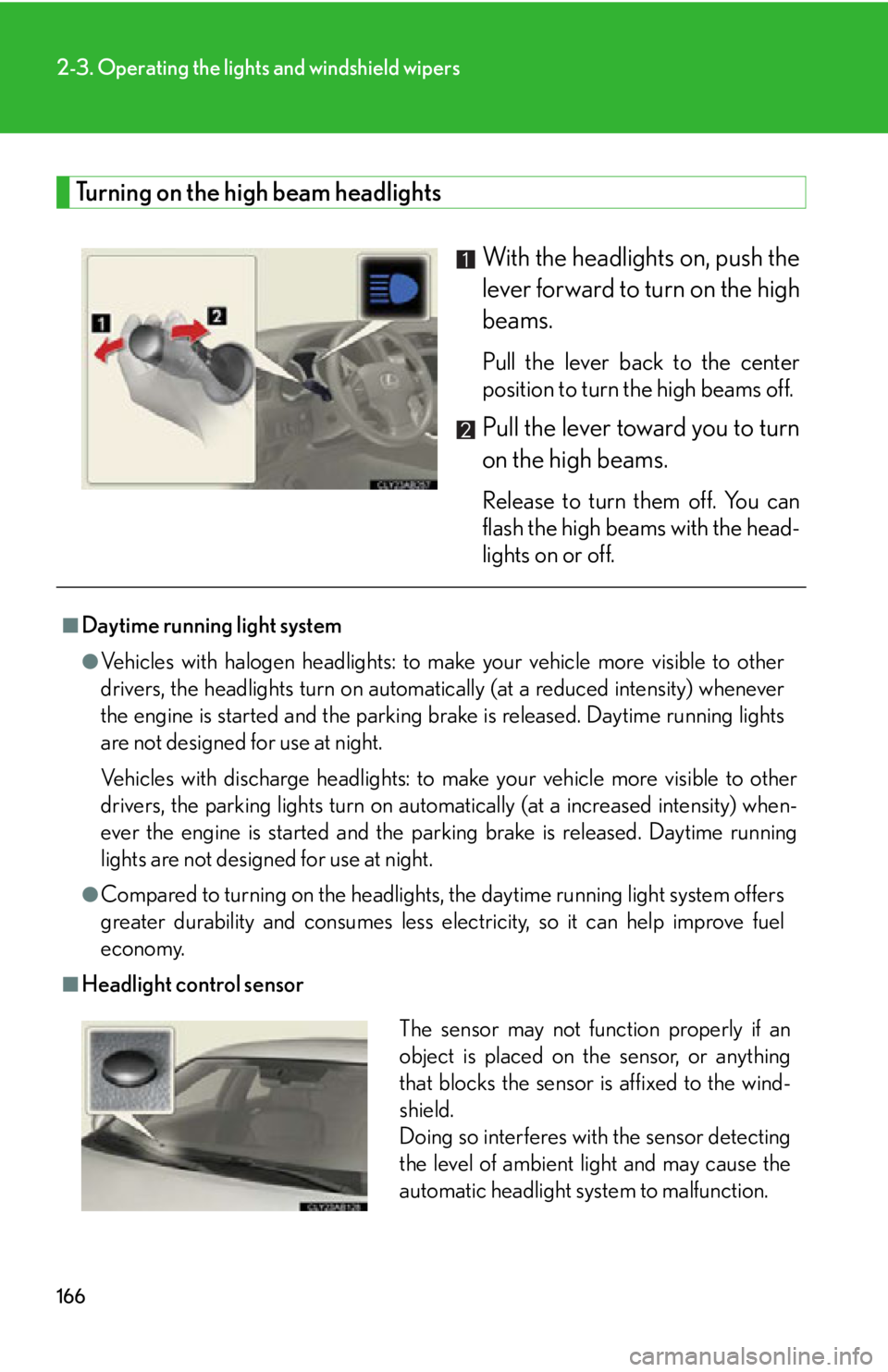
166
2-3. Operating the lights and windshield wipers
Turning on the high beam headlightsWith the headlights on, push the
lever forward to turn on the high
beams.
Pull the lever back to the center
position to turn the high beams off.
Pull the lever toward you to turn
on the high beams.
Release to turn them off. You can
flash the high beams with the head-
lights on or off.
■Daytime running light system
●Vehicles with halogen headlights: to make your vehicle more visible to other
drivers, the headlights turn on automatically (at a reduced intensity) whenever
the engine is started and the parking brake is released. Daytime running lights
are not designed for use at night.
Vehicles with discharge headlights: to make your vehicle more visible to other
drivers, the parking lights turn on automatically (at a increased intensity) when-
ever the engine is started and the pa rking brake is released. Daytime running
lights are not designed for use at night.
●Compared to turning on th e headlights, the daytime running light system offers
greater durability and consumes less electricity, so it can help improve fuel
economy.
■Headlight control sensor
The sensor may not function properly if an
object is placed on the sensor, or anything
that blocks the sensor is affixed to the wind-
shield.
Doing so interferes with the sensor detecting
the level of ambient light and may cause the
automatic headlight system to malfunction.